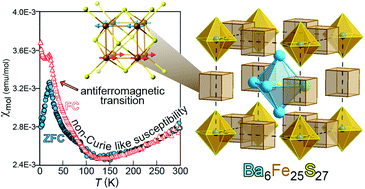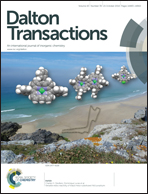Magnetically stabilized Fe8(μ4-S)6S8 clusters in Ba6Fe25S27†
Abstract
We have prepared Ba6Fe25S27, and studied its magnetic properties and electronic structure. Single crystal diffraction revealed a cubic phase (Pm![[3 with combining macron]](https://www.rsc.org/images/entities/char_0033_0304.gif) m) with a = 10.2057(9) Å and Z = 1. Within the large cubic cell, tetrahedrally coordinated Fe atoms arrange into octonuclear Fe8(μ4-S)6(S8) clusters, which can be described as a cube of Fe atoms with six face-capping and eight terminal S atoms. SQUID magnetometry measurements reveal an antiferromagnetic transition at 25 K and anomalous high-temperature dependence of magnetic susceptibility that is non-Curie like—two magnetic signatures which mimic behavior seen in the parent phases of Fe-based superconductors. Using a combined DFT and molecular orbital based approach, we provide an interpretation of the bonding and stability within Ba6M25S27 (M = Fe, Co, Ni) and related M9S8 phases. Through a σ-bonding molecular orbital model of the transition metal coordination environments, we illustrate how the local stability can be enhanced through addition of Ba. In addition, we perform spin-polarized DFT calculations on Ba6Fe25S27 to determine the effect of adopting an antiferromagnetic spin state on its electronic structure. By studying the magnetic properties from an empirical and computational perspective, we hope to elucidate what aspects of the magnetic structure are significant to bonding.
m) with a = 10.2057(9) Å and Z = 1. Within the large cubic cell, tetrahedrally coordinated Fe atoms arrange into octonuclear Fe8(μ4-S)6(S8) clusters, which can be described as a cube of Fe atoms with six face-capping and eight terminal S atoms. SQUID magnetometry measurements reveal an antiferromagnetic transition at 25 K and anomalous high-temperature dependence of magnetic susceptibility that is non-Curie like—two magnetic signatures which mimic behavior seen in the parent phases of Fe-based superconductors. Using a combined DFT and molecular orbital based approach, we provide an interpretation of the bonding and stability within Ba6M25S27 (M = Fe, Co, Ni) and related M9S8 phases. Through a σ-bonding molecular orbital model of the transition metal coordination environments, we illustrate how the local stability can be enhanced through addition of Ba. In addition, we perform spin-polarized DFT calculations on Ba6Fe25S27 to determine the effect of adopting an antiferromagnetic spin state on its electronic structure. By studying the magnetic properties from an empirical and computational perspective, we hope to elucidate what aspects of the magnetic structure are significant to bonding.


 Please wait while we load your content...
Please wait while we load your content...